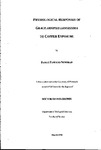PHYSIOLOGICAL RESPONSES OF GRACILARIOPSIS LONGISSIMA TO COPPER EXPOSURE
| dc.contributor.author | NEWMAN, JAMES EDWARD | |
| dc.contributor.other | School of Biological and Marine Sciences | en_US |
| dc.date.accessioned | 2013-10-28T11:59:32Z | |
| dc.date.available | 2013-10-28T11:59:32Z | |
| dc.date.issued | 1998 | |
| dc.identifier | NOT AVAILABLE | en_US |
| dc.identifier.uri | http://hdl.handle.net/10026.1/2413 | |
| dc.description.abstract |
Seaweeds fulfil many of the criteria regarded as being important for a good biomonitor. They are known to accumulate trace metals and the concentration of these metals measured in the thalli of native populations has been related to the level of contamination in the surrounding water. However, this passive biomonitoring approach has been of limited use and the relationship between the concentration of metal in the seaweed and that in the surrounding environment is not always apparent. The aim of this study was to investigate the response of the rhodophyte Gracilariopsis longissima to copper exposure, in the laboratory and field, in order to increase the understanding of the toxic effects of the metal and ultimately to assess the potential of this species as a biomonitor of trace metal pollution. A series of comparative physiological experiments were performed to assess the relative effects of copper on the growth and physiology of the species. Growth was reduced at significantly lower levels of copper {l2µg Lˉ¹) than any other physiological parameter measured. Photosynthesis, as measured by oxygen evolution and fluorescence measurements, was only reduced at high copper treatments (250-400µg Lˉ¹). This coincided with the actual shrinkage of the algal material, increased ion leakage and loss of pigmentation. One possible explanation for the uncoupling of growth from photosynthesis was investigated and rejected. Copper accumulated in the thallus of exposed material as a linear function of the copper treatment. Algal material was able to recover, in terms of growth, following exposure to elevated levels of copper. This recovery coincided with a significant release of copper from the thalli and a resulting increase of copper in the recovery media. This discovery suggests that the accumulated metal is not irreversibly bound to the thalli, and has important implications in terms of using the species as a biomonitor of copper pollution. Populations of G. longissima collected from sites known to differ in trace metal contamination were exposed to copper in a series of laboratory based experiments to measure the effect of the metal on their growth. Exposure to elevated levels of copper significantly reduced growth. However, no major difference existed between the response of the populations compared. Possible explanations for this are discussed. Considerable inter and intra-individual variability was found to exist within populations of G. longissima and causes and implications of this mostly overlooked source of variation are highlighted. A field method of active biomonitoring using reciprocally transplanted individuals was developed as an alternative to passive biomonitoring and was found to offer a number of distinct advantages. In particular, the ability to observe responses to copper in areas where no natural population occurred was explored at a highly contaminated site. | en_US |
| dc.language.iso | en | en_US |
| dc.publisher | University of Plymouth | en_US |
| dc.title | PHYSIOLOGICAL RESPONSES OF GRACILARIOPSIS LONGISSIMA TO COPPER EXPOSURE | en_US |
| dc.type | Thesis | |
| dc.identifier.doi | http://dx.doi.org/10.24382/4549 | |
| dc.identifier.doi | http://dx.doi.org/10.24382/4549 |
Files in this item
This item appears in the following Collection(s)
-
01 Research Theses Main Collection
Research Theses Main


